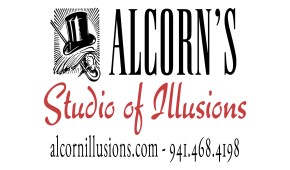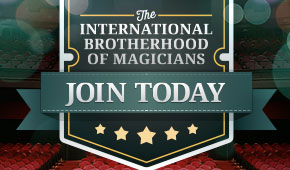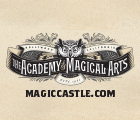The Linking Ring History - Part III
After the infamous stock market crash of October 29, 1929, not even economists or experienced businessmen foresaw that the most crushing economic woes of the twentieth century lay ahead. For the next decade – and into the 1940s in some countries – the economy spiraled downward with plummeting property prices, falling wages, and staggering unemployment rates.
 Against this bleak background – an era when people were forced to choose between buying food and clothes for their families or spending money on a hobby, such as magic – W. W. Durbin’s capable management kept the International Brotherhood of Magicians alive with a growing number of Rings, annual conventions, and the monthly publication of The Linking Ring.
Against this bleak background – an era when people were forced to choose between buying food and clothes for their families or spending money on a hobby, such as magic – W. W. Durbin’s capable management kept the International Brotherhood of Magicians alive with a growing number of Rings, annual conventions, and the monthly publication of The Linking Ring.
Durbin’s years as editor of The Linking Ring and President of the I.B.M. were fraught with challenges. Despite his best efforts, revenue declined dramatically during the Great Depression. In May 1929, gross annual receipts for the I.B.M. totaled $21,375. By 1934, that number had plunged more than seventy-five percent to $4,617. Annual advertising revenues fell from $3,585 in 1930 to $1,263 in 1934. Yet year after year, Durbin maintained a balanced budget, reducing expenses as necessary and continuing his enthusiastic promotion to obtain new members.
 The total number of magicians who joined the I.B.M. continued to rise during the Depression, but as economic woes increased, the number of paid up members declined. At the Annual Convention in June 1930, President Durbin delivered an inspiring speech about the growth of the I.B.M. Since its inception, he said, the organization had enrolled about 4,000 members and fifty-three local Rings had been established. The Linking Ring, which averaged forty pages when Durbin assumed the editorship, had expanded to as many as 172 pages.1 Durbin concluded his speech with praise for the committees and officers who were working with him.
The total number of magicians who joined the I.B.M. continued to rise during the Depression, but as economic woes increased, the number of paid up members declined. At the Annual Convention in June 1930, President Durbin delivered an inspiring speech about the growth of the I.B.M. Since its inception, he said, the organization had enrolled about 4,000 members and fifty-three local Rings had been established. The Linking Ring, which averaged forty pages when Durbin assumed the editorship, had expanded to as many as 172 pages.1 Durbin concluded his speech with praise for the committees and officers who were working with him.
By 1935, annual dues collected indicate fewer than 950 members paying their renewals, plus 220 new members joining. (Applying for membership cost $3.00, which included six issues of The Linking Ring. Thereafter, membership was $2.50 per year, which included twelve issues.) “You know, Al,” Durbin wrote to Alfred P. Saal, a member of the I.B.M. Executive Committee, on October 19, 1931, “that with the hard times you have an awful time to keep fellows paid up on their dues. Some of the very best fellows that we have and that you would think would never fail to send in their dues are in arrears and letter after letter sent them only brings back the answer that while they would like to continue, they can’t spare the money.… I know this, that when fellows get the magic bug they will almost go without their meals to get a magic magazine, but when it gets down to it that he doesn’t have enough money to take care of the kiddies, then I can see why he would drop out so that he will have money to buy something to exist on.”2
Times were hard, but the I.B.M. retained enough members to continue publishing The Linking Ring. Under Durbin’s editorship, the magazine became a charming hodgepodge of magic news and information. The Linking Ring included history, tricks, patter, opinions, news of I.B.M. Rings, convention promotion, convention reviews, profiles of magicians, obituaries and tributes, letters, and advertisements. As an editor, Durbin was not exacting in his grammar and punctuation, and his sentences often needed to take a breath before reaching the end. But the content was a colorful mixture of fascinating information. A busy executive with a hundred employees working for him in the Scioto Sign Company, Durbin relied on dictation not only to conduct extensive correspondence with members but also to write his monthly articles. From the rambling, conversational tone of his columns, one can almost see Durbin leaning back in his office chair, regaling friends with stories of magicians from days gone by or rendering opinions on the current state of the art.
Now in his sixties, Durbin had met many of the great magicians of the previous half-century. He had been on friendly terms with Houdini and, like Houdini, had hundreds of letters from Harry Kellar. Durbin had also met Alexander Herrmann and a host of magical luminaries. In his Egyptian Hall, a 150-seat theater and museum behind his home, he had entertained magicians since its construction in 1895. Durbin felt so strongly about the importance of magic history that he featured great magicians of the past on the cover of The Linking Ring for three years, from 1929 through 1931.
 For artwork, he enlisted the services of Elmer E. Douglas of Norcross, Ohio. Twenty-five-year-old Douglas was an enthusiastic member who had written articles about advertising and promotion for magicians. Also a talented artist, his first cover design for The Linking Ring was a portrait of Robert-Houdin for the January 1929 issue. Other portraits he completed included Harry Kellar, Compars Herrmann, and Ching Ling Foo. By summer, however, Douglas’ wife was ill, and he was unable to continue. Durbin arranged for The Linking Ring’s associate artist Merle Fleming of Kenton, Ohio, to provide a portrait of Bautier de Kolta and John Henry Anderson for the July and August issues respectively. Fleming admirably matched the artistic style of his predecessor.
For artwork, he enlisted the services of Elmer E. Douglas of Norcross, Ohio. Twenty-five-year-old Douglas was an enthusiastic member who had written articles about advertising and promotion for magicians. Also a talented artist, his first cover design for The Linking Ring was a portrait of Robert-Houdin for the January 1929 issue. Other portraits he completed included Harry Kellar, Compars Herrmann, and Ching Ling Foo. By summer, however, Douglas’ wife was ill, and he was unable to continue. Durbin arranged for The Linking Ring’s associate artist Merle Fleming of Kenton, Ohio, to provide a portrait of Bautier de Kolta and John Henry Anderson for the July and August issues respectively. Fleming admirably matched the artistic style of his predecessor.
Sadly, Douglas’ wife died in childbirth in August. He was left with two children but resumed his duties as cover artist in the fall of 1929. Thereafter, instead of “Elmer E. Douglas,” the name of a Cincinnati firm, Repro Engraving Company, was credited. A later editor, Alvin Plough, stated that Douglas was the artist for these covers, as well. Durbin’s historical series ran through the end of 1931, and thirty-four great magicians of the past had been honored.3 Douglas, the artist who served the I.B.M. even through his grief, died a year and a half later at age twenty-nine.
For the first year of this series, Durbin wrote short biographical sketches of each performer. Thereafter, the task fell to Henry Ridgely Evans (1861-1949), a prominent historian of magic and the occult. The author of such engaging titles as Hours with the Ghosts (1897), Magic and Its Professors (1902), The Spirit World Unmasked (1902), Adventures in Magic (1927), and The History of Conjuring and Magic (1928), Evans was a leading historian in the field. He worked as an editorial assistant for the U. S. Bureau of Education and eventually served as acting editor of the department. A former columnist for The Sphinx, Evans began writing for The Linking Ring and became the official I.B.M. Historian, thanks to Durbin’s persuasion. Evans wrote a Christmas message in the December 1928 issue, and beginning in January 1929 his featured column appeared on the first page of each issue. He began with autobiographical notes in a series entitled, “Flying Leaves from the Journal of an Amateur Magician and Mystic,” but eventually covered many historical topics related to magic and magicians.
Other contributors to The Linking Ring included John Booth (“Booth’s Mystic Trix”), Doc Nixon (“Nixon’s Free for All Corner”), T. J. Crawford (“Have a Card”) Gene Gordon (“Within the Shuffle”), Robert Nelson (“With the Mentalists”) Burt Douglas (“Magic for Men”), F. H. Keller (“Letters of Harry Kellar”), and W. W. Durbin (“Notes and Jottings”).
Durbin’s personality and opinions peppered each issue of the magazine. Considered by many to be the hero of the I.B.M., Durbin was fondly referred to as “Uncle Bill,” “Brother Durbin,” or “Colonel Durbin.” Among his supporters was Howard Thurston whose Wonder Show of the Universe had enthralled audiences for decades. On January 6, 1931, Thurston wrote to Durbin from the Alvin Theatre in Pittsburgh, Pennsylvania.
Dear Mr. Durbin:- Congratulations on the quality, quantity and general make up of the Christmas Linking Ring. I was amazed not only with the great number of pages, but the contents, which brought me messages from many of my good friends throughout the world. It is a triumph that has never been equaled in a magical magazine. It is another demonstration of the ability of the editor and a tribute of affection to “Uncle Bill” from his many friends. Cordially, Howard Thurston (signed)
In addition to admirers such as Thurston, he also had his share of detractors. Durbin was opinionated, outspoken and powerful, and from the beginning of his “takeover” of the I.B.M. acquired enemies who unsuccessfully challenged his authority. Dr. A. M. Wilson, crotchety editor and publisher of The Sphinx, was among the harshest critics.
Wilson had been complimentary of The Linking Ring when the first twelve-page printed copy rolled off the press in 1925 after three years of mimeographed editions. But as the I.B.M. gained members and momentum under Durbin’s leadership, he became obsessed by The Linking Ring’s threat to The Sphinx. With I.B.M. co-founder Len Vintus urging him on, Wilson hurled petty complaints and libelous accusations toward Durbin. Meanwhile, The Linking Ring continued to flourish.
Although Wilson attended the second I.B.M. Convention in Kenton in June 1927 and praised the organization, his tone darkened in his August editorial. Wilson wrote: “I am as loyal a member as is Mr. Durbin or any other member, but am not blinded by the influx of members and the rapid accumulation of money. I see breakers ahead: Ponzi and the Julian episodes in finance are being paralleled in the I.B.M.” Then, oddly, he complains that the I.B.M. Convention only benefited the group of magicians who attended. “Did it ever occur to the members of the I.B.M. what a busy man Bro. Durbin must be and the heavy burden he is carrying alone?” Wilson continues. “He is president, treasurer of the I.B.M., editor and advertising manager of The Linking Ring, receives all the applications and the money….As no treasurer has [ever] been elected….it naturally follows that Bro. Durbin must look after the money….” Wilson then calculates how much money the I.B.M. has received in the past two months, making huge mathematical errors by misplacing the decimal in his multiplication and wildly guessing at the profit made by the convention. He eventually concludes that Durbin has received “a total of $12,300 to be cared for, which in itself is no little job.”
Wilson veers off on a rant about how the I.B.M. accepts members, then turns to other magic news for a full column. On the next page, he jumps back to a complaint about an effect that appeared in The Linking Ring, saying he had seen it done by John Mulholland in 1925. The next paragraph is about the I.B.M. offering to help magicians protect their inventions; he himself has been doing this for years. Nestled between other magic news, Wilson mentions the I.B.M. three more times, finally concluding with the news that “Horace Goldin has resigned from the I.B.M. and in the Billboard of August 6th gives as his reason that his name was not mentioned in the I.B.M. convention program or otherwise remembered in any way.”
Durbin responded to Wilson’s insinuations of financial mismanagement in a letter dated August 23, 1927. “Now it is not my purpose to enter into any long quarrel with you about what you think about the I.B.M. because fortunately it don’t make any difference what you think….” Durbin demands an apology and swiftly dissects Wilson’s bad math and unfounded assumptions of financial misconduct. “So far as your attitude toward the I.B.M. is concerned,” he concludes, “I have a well defined notion that any man who wants to shoot at an organization ought to shoot from without and not from within. Whenever I want to fight an organization I will never be found inside that organization stabbing my brothers in the back.” Even Len Vintus, not usually a Durbin supporter, wrote to Wilson: “Do you know that last year Mr. Durbin kept his private secretary continually busy for the entire 12 months attending practically solely to I.B.M. correspondence? Do you know that he employed a clerk to look after routine duty as well[?]”
 Wilson was not alone in his objections to Durbin’s control of the organization and its official publication. I.B.M. member 1500 and one-time Membership Chairman Walter H. Domzalski of Detroit, Michigan, became an outspoken opponent. Late in 1931, Domzalski prepared a “questionnaire” that was sent to all members, with questions designed to instill doubt into members’ minds regarding Durbin’s motives and fairness in running the organization. In the December 1931 issue, Durbin responded with a full-page notice: “We have just received a copy of a circular letter that has been sent out by a party in Detroit, Mich., in the shape of a questionnaire, and a reading of it discloses the apparent purpose of the writer….” To avoid the appearance of a petty attack on Durbin, Domzalski had omitted his own name from the letter and arranged for it to be mailed by another member. Durbin continues: “While the circular bears the name of the person who sends it out it is well known that he is only the tool of the real person who dictated the letter but who is so cowardly that he remains in the back ground and has some one else do his dirty work for him. The questions are full of insults not only to the President of this order but to other officers and members who are entitled to better treatment….There will be a Convention in Kenton next June, let them come, if they dare, and then we will see what there is to all their contentions.”
Wilson was not alone in his objections to Durbin’s control of the organization and its official publication. I.B.M. member 1500 and one-time Membership Chairman Walter H. Domzalski of Detroit, Michigan, became an outspoken opponent. Late in 1931, Domzalski prepared a “questionnaire” that was sent to all members, with questions designed to instill doubt into members’ minds regarding Durbin’s motives and fairness in running the organization. In the December 1931 issue, Durbin responded with a full-page notice: “We have just received a copy of a circular letter that has been sent out by a party in Detroit, Mich., in the shape of a questionnaire, and a reading of it discloses the apparent purpose of the writer….” To avoid the appearance of a petty attack on Durbin, Domzalski had omitted his own name from the letter and arranged for it to be mailed by another member. Durbin continues: “While the circular bears the name of the person who sends it out it is well known that he is only the tool of the real person who dictated the letter but who is so cowardly that he remains in the back ground and has some one else do his dirty work for him. The questions are full of insults not only to the President of this order but to other officers and members who are entitled to better treatment….There will be a Convention in Kenton next June, let them come, if they dare, and then we will see what there is to all their contentions.”
Next June, as Durbin stated, there was a convention in Kenton, Ohio. There was also a big surprise, which made the headlines of the June 7, 1932 edition of The Lima News. A front-page story reported that Walter H. Domzalski of Detroit had filed a lawsuit against Durbin for one million dollars.
---------------------------













